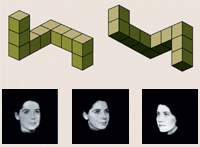
mental imagery and
face processing abilities
The distinct biological basis of sign language results in a unique interaction between vision and language and between action systems and language production. This project investigates the possible effects of experience with a visual-spatial language and the effects of auditory deprivation from birth on non-language visual perception and on spatial cognition. Specifically, we are addressing the following questions using behavioral methods and neuroimaging:
- How does knowing a visual-spatial language affect visual-spatial cognition?
- Do visual perspective taking abilities differ between deaf signers and hearing speakers?
- Why does short term memory span differ between speech and sign?
- Are theories of action perception and production relevant to sign language?
Funding
This research is supported by the National Institute of Deafness and Other Communication Disorders (R01 DC101977) and by the National Institute on Child Health and Human Development (R01 HD13249).
Recent Publications
- Declerck, M., Meade, G., Midgley, K., Holcomb, P., Roelofs, A., & Emmorey, K. (2021). On the connection between language control and executive control – an ERP study. Neurobiology of Language, 2(4), 628-646. https://direct.mit.edu/nol/article/2/4/628/97421/On-the-Connection-Between-Language-Control- or email to request PDF
- Meade, G., Lee, B., Massa, N., Holcomb, P.J., Midgley, K.J., & Emmorey, K. (2022). Are form priming effects phonological or perceptual? Electrophysiological evidence from American Sign Language. Cognition. 220, 104979. https://pubmed.ncbi.nlm.nih.gov/34906848/
- Emmorey, K. (2021). Environmentally-coupled signs and gestures. Journal of Cognition, 4(1), 1–3. https://www.ncbi.nlm.nih.gov/pmc/articles/PMC8396116/
- Pyers, J. E., Magid, R., Gollan, T., & Emmorey, K. (2021). Gesture helps, only if you need it: The relationship between gesture, short term memory, and lexical retrieval. Cognitive Science, 45, 1-26. https://pubmed.ncbi.nlm.nih.gov/33389787/
- Brozdowski, C., & Emmorey, K. (2020). Shadowing in the manual modality. Acta Psychologica, 208. PMCID: PMC7387226 https://doi/org/10.1016/j.actpsy.2020.103092
- Ries, S., Nadalet, L., Mickelson, S., Mott, M., Midgley, K. J., Holcomb, P.J., & Emmorey, K. (2020). Pre-output language monitoring in sign production. Journal of Cognitive Neuroscience, 32(6), 1079-1091. PMCID: PMC7234262 https://doi.org/10.1162/jocn_a_01542
- Secora, K., & Emmorey, K. (2020). Visual perspective-taking in spatial scenes and in American Sign Language. Journal of Deaf Studies and Deaf Education. PMCID: PMC pending https://doi.org/10.1093/deafed/enaa006
- Sehyr, Z.S., Midgley, K. J., Holcomb, P.J., Emmorey, K., Plaut, D. C., & Behrmann, M. (2020). Unique N170 asymmetries to visual words and faces reflect experience-specific adaptation in adult deaf ASL signers. Neuropsychologia, 141, 107414. PMCID: PMC7192317 http://www.elsevier.com/locate/neuropsychologia.2020.107414
- Secora, K., & Emmorey, K. (2019). Social abilities and visual-spatial perspective-taking skill. Journal of Deaf Studies and Deaf Education, 24(3), 201–213.
- Sehyr, Z.S., & Emmorey, K. (2019). The perceived mapping between form and meaning in American Sign Language depends on linguistic knowledge and task: Evidence from iconicity and transparency judgments. Language and Cognition, 11, 208-234.
Recent Presentations
- Brozdowski, C., & Emmorey, K. (2018). Shadowing linguistic and non-linguistic body movements. Paper presented at the International Society for Gesture Studies, July, Cape Town, South Africa.
- Ries, S., Mickelsen, S., Nadalet, L., Mott, M., Midgley, K. J., Holcomb, P.J., & Emmorey, K. (2018). Pre-output language monitoring in sign production. Poster presented at the Society for the Neurobiology of Language, August, Québec City, Canada. (pdf)
- Emmorey, K., & Pyers, J. (2017). Cognitive biases in construing iconic mappings. 11th International symposium on iconicity in language and literature. April, Brighton, UK.
- Emmorey, K. (2017). What sign production can tell us about speech production. CNS Satellite symposium: Neural bases of speech production, March, San Francisco, CA.
- Emmorey, K. (2014). What sign languages reveal about the face. Invited instructor for the Summer school on “What faces can reveal about social and cognitive processes”, Bicocca University, June, Milan, Italy.

